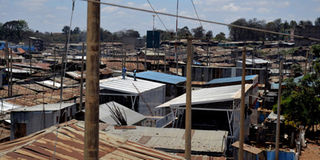The poor have right to land in towns

A section of the Mathare slums in Nairobi on September 24, 2014. In Nairobi, the poor make up 60 per cent of the population. Yet, they occupy only 5 per cent of the residential space. This space, without any formal land tenure, is in congested housing without basic services such as water, electricity, and toilets. FILE PHOTO | NATION MEDIA GROUP
What you need to know:
- In Nairobi, the poor make up 60 per cent of the population. Yet, they occupy only 5 per cent of the residential space.
- Population in most of these areas can be higher than 1,000 people per hectare whereas in Muthaiga, one of the prime residential areas, is zoned off to give each family at least half-an-acre.
- To compound the problem of informal settlers, the law regards them as squatters who can be evicted without notice and without caring where they go.
- However, the new Constitution as well as the eviction procedure guidelines have seen courts make rulings declaring forced evictions unconstitutional.
- City dwellers must be given the right to pursue a livelihood in an organised manner so that second-hand goods merchants are not continually harassed and penalised by law-enforcement agents.
On December 17, 2010, Mohamed Bouazizi, a second-hand wares seller in Sidi Bou Said, a town in northern Tunisia, set himself ablaze to protest at the harassment of municipal officials, who prevented him from selling his goods on the streets.
A few months later, this desperate act triggered mass demonstrations, revolts, and revolutions that came to be known as the Arab Spring.
The incident captured the inevitable consequence of the global urban tragedy where exclusion of the poor and other marginalised groups has become official policy and practice.
In Nairobi, the poor make up 60 per cent of the population. Yet, they occupy only 5 per cent of the residential space.
This space, without any formal land tenure, is in congested housing without basic services such as water, electricity, and toilets.
Population in most of these areas can be higher than 1,000 people per hectare whereas in Muthaiga, one of the prime residential areas, is zoned off to give each family at least half-an-acre.
To compound the problem of informal settlers, the law regards them as squatters who can be evicted without notice and without caring where they go.
NEW CONSTITUTION
However, the new Constitution as well as the eviction procedure guidelines have seen courts make rulings declaring forced evictions unconstitutional.
The absence of a strong grassroots movement has accentuated this continued exclusion and marginalisation of the urban poor.
They are on the periphery of political power. Their ability to exercise the right of participation in decision-making is compromised.
To that extent, they are not victims of violation of human rights because of their status but because they are largely unable to influence decisions.
In contrast, affluent neighbourhoods have strong residents’ associations that negotiate with the government and influence decisions.
Policy formulation and implementation is still overwhelmingly based on a technocratic concept of development.
For example, the right to housing is reduced to shelter and service delivery. It assumes that progress can be measured by counting the delivery of housing units and service connections to beneficiaries.
Meaningful participation of the urban poor is considered a ritual, hence the current problem facing the slum upgrading programme.
The Soweto East Upgrading process was subjected to a court case because a section of the beneficiaries cited lack of participation.
The Mombasa county government has rolled out an initiative for urban renewal of the old estates.
PROPOSED FRAMEWORKS
Hopefully, it will be guided by some of the proposed frameworks in the national slum upgrading and urban development policies, the Urban Areas and Cities Act, and the Physical Planning Act.
The National Land Commission should also be involved in the process of the urban renewal of houses proposed to be undertaken through a public-private partnership because most are on public land.
Ideally, urban areas should offer opportunities to all the people living there. The right of everyone, especially the poor, to an urban life means that the social value of land should be prioritised over its commercial worth.
The right of women to be safe in the city, the right of safe convenient and affordable transport, the right to public space with public toilets, drinking fountains, and benches must be part of a reformed city.
City dwellers must be given the right to pursue a livelihood in an organised manner so that second-hand goods merchants are not continually harassed and penalised by law-enforcement agents.
The right to shape the city means that ordinary citizens, and especially the poor, have the right to organise themselves and challenge power and be engaged in governance as well as exercise their social accountability over development projects undertaken in cities.
The Constitution has opened up opportunities for the urban poor. Some of the national values embodied in the Constitution include human dignity, equity, and social justice, participation of the people and protection of the marginalised.
Jurisprudence under the new Constitution is beginning to translate some of these principles into tangible benefits for the urban poor.
How far this will go will depend on the level of the social and political organisation of these people.
The author is the executive director of Hakijamii. [email protected]




